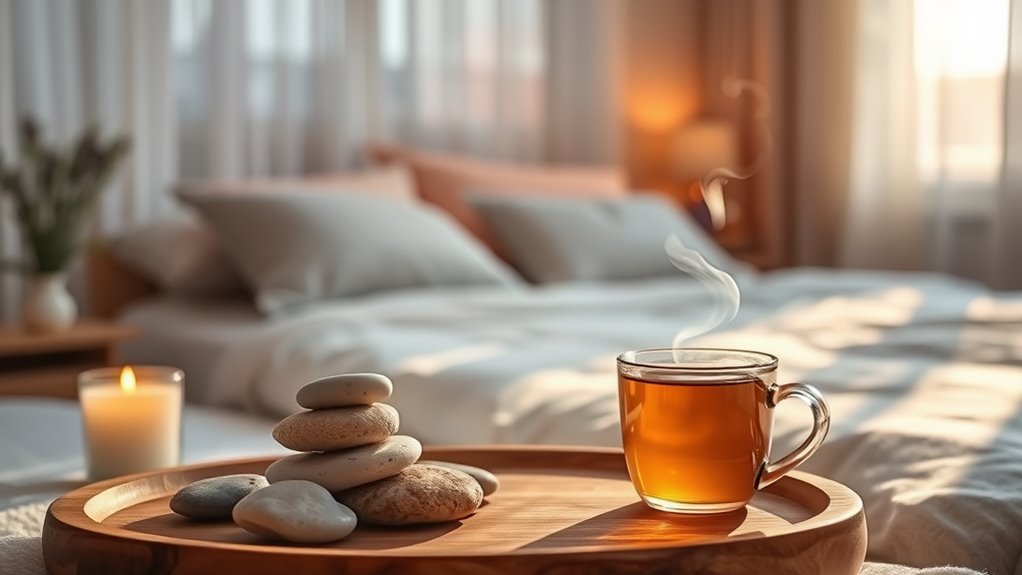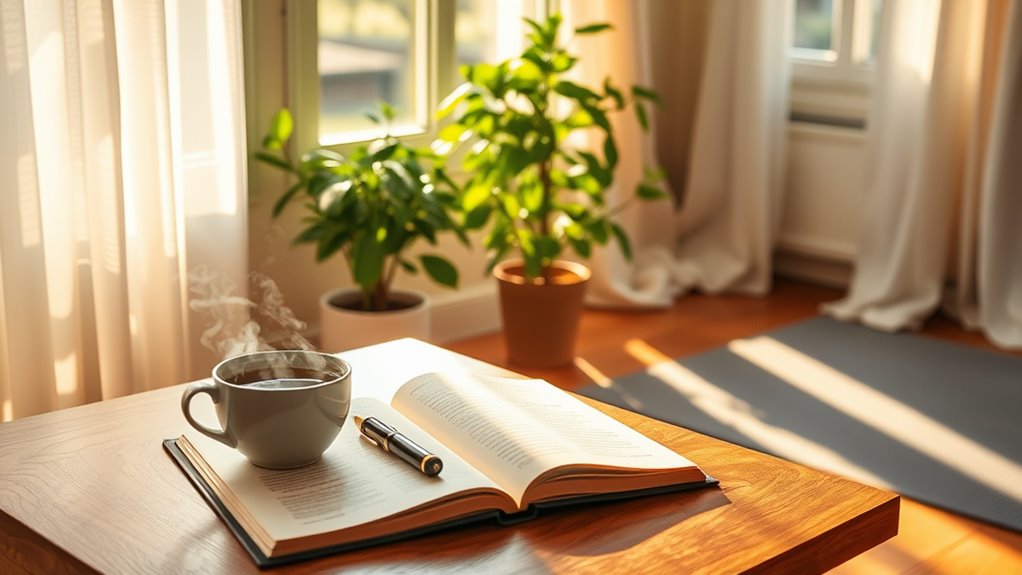This Breathing Exercise Will Help You Sleep Better Tonight
Try this breathing exercise tonight to enhance your sleep quality. Focus on diaphragmatic breathing: inhale deeply through your nose for a count of four, hold for seven, and exhale slowly through your mouth for a count of eight. This technique calms your mind and signals your body to unwind. Pair it with creating a relaxing environment, and you’ll boost your chances of a restful night. Discover other helpful strategies to elevate your sleep even more.
Key Takeaways
- Practice the 4-7-8 breathing technique by inhaling for 4 seconds, holding for 7, and exhaling for 8 to promote relaxation and sleep onset.
- Engage in diaphragmatic breathing by focusing on deep, slow breaths to lower heart rate and reduce anxiety before bedtime.
- Create a calming environment by dimming lights and optimizing room temperature to signal your brain it’s time to rest.
- Incorporate short breathing sessions of 10-15 minutes into your nightly routine to prepare the body for sleep and enhance relaxation effects.
- Consistently practice breathing exercises to train your mind and body, reinforcing a calm state conducive to better sleep quality.
The Importance of Sleep for Overall Health
Sleep isn’t just a luxury; it’s crucial for your overall health. You mightn’t realize it, but quality sleep governs your physical and mental well-being. When you skimp on rest, your body struggles to recover, affecting your immune function and cognitive clarity.
Prioritizing sleep can boost your focus, mood, and resilience to stress. Moreover, the essential role of sleep in self-care cannot be overstated, as it plays a vital part in maintaining optimal well-being.
Incorporating breathing exercises and meditation into your nightly routine can greatly enhance your sleep quality. These practices help calm your mind, slow your heart rate, and prepare your body for restorative rest.
Understanding the Connection Between Breathe and Sleep
Your breath plays an essential role in how well you sleep each night.
When you regulate your breathing, you can greatly improve sleep quality and enhance relaxation.
Let’s explore some effective techniques that can help you harness the power of your breath for better rest.
Incorporating soothing breathing exercises into your nightly routine can help ease your mind and prepare your body for sleep.
Importance of Breath Regulation
As you navigate the complexities of daily life, understanding the connection between breath regulation and sleep quality can greatly impact your overall well-being.
Your breath serves as a bridge between your mind and body, influencing your state of relaxation and readiness for rest. When you regulate your breath, you activate the parasympathetic nervous system, promoting calmness and reducing stress.
This control helps create an environment conducive to sleep by lowering your heart rate and fostering a sense of safety. Practicing intentional breathing not only enhances your ability to fall asleep but also encourages deeper sleep cycles.
Mastering breath regulation empowers you to take charge of your relaxation techniques, ultimately enriching your nightly restoration process. Embrace this essential skill for a healthier sleep routine.
Impact on Sleep Quality
Understanding how breath regulation affects the quality of your sleep can elevate your nightly restorative process. Proper breath control reduces anxiety and promotes relaxation, both essential for deeper sleep. When you focus on your breathing, you signal your body that it’s time to wind down.
| Breathing Technique | Effect on Sleep Quality | Time to Practice |
|---|---|---|
| Diaphragmatic Breathing | Lowers heart rate, induces calm | 5 minutes before bed |
| Box Breathing | Increases focus, reduces stress | 10 minutes in evening |
| 4-7-8 Breathing | Fosters relaxation, improves onset | 5 minutes nightly |
| Equal Breathing | Balances emotions | Anytime during the day |
| Alternate Nostril Breathing | Promotes mental clarity | 5-10 minutes if needed |
Incorporating these techniques enhances sleep quality effectively.
Relaxation Techniques for Sleep
Many people overlook the profound connection between relaxation techniques and sleep quality. Mastering relaxation isn’t just about winding down; it involves strategically employing methods that invite restful slumber.
Breathing exercises, for instance, can shift your body into a calmer state by reducing stress and lowering heart rate. Incorporating techniques like progressive muscle relaxation or guided imagery further enhances this effect, creating a serene mental space.
Spend a few minutes each evening focusing on deep, slow breaths. Imagine inhaling tranquility and exhaling tension. You’ll train your mind and body to associate these techniques with sleep, reinforcing better rest over time.
Preparing Your Space for Relaxation
To get the most out of your breathing exercises for better sleep, your space needs to promote relaxation.
Start by decluttering your sleep area, adjusting the lighting, and optimizing the room temperature. Each small change can make a big difference in how well you unwind. Incorporating a straightforward evening routine can further enhance your relaxation and improve sleep quality.
Declutter Your Sleep Area
Although you mightn’t realize it, the clutter in your sleep area can greatly impact your ability to relax and fall asleep. A disorganized space can create stress, making it harder to unwind.
Here’s how to declutter effectively:
-
Remove Non-Sleep Items: Clear away work materials, exercise gear, or anything unrelated to sleep. This helps signal your brain that it’s time to rest.
-
Organize Bedding: Fold or neatly store any extra blankets and pillows. A tidy bed promotes a serene atmosphere.
-
Limit Surface Clutter: Keep your nightstand minimal—just a lamp and perhaps a book you’re genuinely reading. This encourages a focused, calm mindset.
Adjust Lighting Conditions
A serene sleep environment goes beyond decluttering; it also involves adjusting the lighting in your space. You want to create a calming atmosphere that signals your body it’s time to wind down.
Start by dimming overhead lights and consider using lamps with warm-toned bulbs. These hues promote relaxation, unlike harsh white light that can disrupt your circadian rhythm.
Blackout curtains can also help eliminate intrusive streetlights, ensuring darkness envelops your room. If you enjoy reading before bed, opt for a low-wattage reading lamp that’s easy on the eyes.
Finally, incorporate adjustable lighting or smart bulbs that allow you to tailor brightness levels as needed. By mastering your lighting conditions, you’re setting the stage for rejuvenating sleep.
Optimize Room Temperature
Finding the right room temperature can greatly enhance your sleep quality, as a cool environment signals your body that it’s time to rest.
To maximize your sleep space, consider these three key factors:
-
Temperature Range: Aim for a room temperature between 60-67°F (15-19°C) for ideal sleep conditions.
-
Bedding Materials: Choose breathable fabrics like cotton or linen that help regulate your body temperature throughout the night.
-
Ventilation: Guarantee proper airflow by slightly opening a window or using a fan to create a revitalizing breeze.
Step-by-Step Guide to the Breathing Exercise
To get started with the breathing exercise, you only need five simple steps.
First, find a quiet, comfortable place to sit or lie down.
Next, close your eyes and take a deep breath in through your nose, counting to four.
Hold that breath for a count of four.
Then, exhale slowly through your mouth for another count of four.
With each exhale, imagine releasing any tension or stress.
Finally, pause for a moment before repeating the cycle.
Continue this process for five to ten minutes, focusing on your breath and letting distractions fade away. Research shows that incorporating deep breathing techniques into your routine can significantly enhance your overall well-being.
Timing: When to Practice the Breathing Technique
Knowing the right timing to practice your breathing technique can enhance its effectiveness for better sleep.
To master this practice, consider these ideal moments:
-
Before Bedtime: Spend 10-15 minutes on your technique as part of your wind-down routine. This helps signal your body that it’s time to sleep.
-
During Stressful Moments: If you feel anxiety creeping in, pause and perform the breathing exercise. This can ground you and prepare you for restful sleep.
-
Upon Waking Up: Start your day by practicing your technique to set a calm tone, making it easier to return to sleep later if needed.
Additionally, practicing these techniques regularly can help develop a mindful approach to managing stress and improving sleep quality.
Tips for Enhancing Your Breathing Exercise Experience
While practicing your breathing exercises, creating an ideal environment can greatly enhance your experience.
Start by finding a quiet space with minimal distractions. Dim the lights or use soft lighting to set a calming atmosphere. Consider incorporating soothing scents, like lavender, to promote relaxation.
Time your practice session when you’re least likely to be interrupted. Sit comfortably with your back straight, ensuring your body is relaxed. You might want to play gentle background music or nature sounds to further aid your focus.
Lastly, before diving into the exercise, take a moment to clear your mind and set a specific intention.
With these adjustments, you’ll cultivate a more profound connection to your breathing and harness its full potential for restful sleep.
Common Challenges and How to Overcome Them
Even with the right environment and mindset, you might still encounter challenges during your breathing exercises.
Here are three common obstacles and how to overcome them:
-
Racing Thoughts: If your mind wanders, gently refocus on your breath. Acknowledge the distraction and return to your rhythm.
-
Physical Discomfort: If you feel tension in your body, adjust your posture. Sit or lie in a position that feels more comfortable to facilitate relaxation.
-
Timing Issues: Consistency is key. If you struggle to find time, schedule a specific time for your exercises daily. Treat it as a crucial appointment for your well-being.
The Science Behind Breathing and Sleep
Understanding the link between breathing and sleep is essential for anyone looking to enhance their rest. The way you breathe can directly impact your nervous system, influencing stress levels and sleep quality. When you practice deep, controlled breathing, you activate your parasympathetic nervous system, promoting relaxation. This helps lower heart rate and blood pressure, making it easier to fall asleep.
Here’s a brief overview of how breathing affects sleep:
| Breathing Technique | Impact on Sleep |
|---|---|
| Deep Breathing | Reduces anxiety |
| Diaphragmatic Breathing | Improves oxygen intake |
| Slow Breathing | Lowers heart rate |
| Box Breathing | Enhances emotional control |
Mastering these techniques empowers you to create a tranquil night routine and enjoy restful sleep.
Additional Relaxation Techniques to Consider
If you’re looking to enhance your relaxation routine, consider trying Progressive Muscle Relaxation and Guided Imagery Techniques.
These methods can help release tension and calm your mind, making it easier to drift off to sleep.
Progressive Muscle Relaxation
One effective technique you might consider for improving your sleep is Progressive Muscle Relaxation (PMR). This method helps release tension and promotes a deep sense of calm.
To practice PMR, follow these steps:
-
Find a Comfortable Position****: Sit or lie down in a quiet space where you won’t be disturbed, allowing your body to relax fully.
-
Tense and Relax: Start from your toes, tense each muscle group for five seconds, then release, feeling the tension melt away. Move systematically through your body up to your head.
-
Focus on Your Breath: As you relax, concentrate on your breathing, inhaling deeply and exhaling slowly, enhancing the relaxation process.
Incorporating PMR into your nightly routine might lead you to deeper, more restorative sleep.
Guided Imagery Techniques
After experiencing the calming effects of Progressive Muscle Relaxation, you might want to explore Guided Imagery Techniques to further enhance your relaxation and sleep quality.
Guided imagery involves visualizing peaceful scenes or experiences, helping your mind disengage from stressors. Start by finding a comfortable position, closing your eyes, and taking deep breaths.
Picture a serene landscape—like a quiet beach or a tranquil forest. Immerse yourself in the details: feel the sun’s warmth, hear the gentle waves, or smell the fresh pine.
Allow yourself to stay in this mental space, focusing on the sensations it evokes. Practicing this technique regularly can deepen your sense of calm, making it easier to shift into restful sleep.
You’re not just imagining; you’re actively creating peace.
Making Breathing Exercises a Part of Your Nightly Routine
Incorporating breathing exercises into your nightly routine can greatly enhance your sleep quality, as it helps calm your mind and relax your body.
To master this practice, follow these three steps:
-
Set a Specific Time: Choose a consistent time each night for your breathing exercises, signaling to your body that it’s time to unwind.
-
Create a Relaxing Environment****: Dim the lights, reduce noise, and find a comfortable space. This environment primes your mind for relaxation.
-
Choose a Technique: Experiment with various methods, such as the 4-7-8 technique or diaphragmatic breathing, to discover what works best for you.
Frequently Asked Questions
Can Children Practice This Breathing Exercise Too?
You can teach children this breathing exercise. It’s simple and effective, helping them relax and focus. Just make sure you guide them gently, making it a fun and engaging experience for better results.
How Long Before Bed Should I Start the Exercise?
Start the exercise about 30 minutes before bedtime. This timeframe allows you to relax and clear your mind, creating a peaceful shift to sleep. Consistency will enhance your mastery and effectiveness over time.
What if I Don’t Feel Any Immediate Improvements?
If you don’t feel immediate improvements, don’t get discouraged. Mastery takes time. Keep practicing consistently, and stay mindful of your progress. Often, subtle changes accumulate into significant benefits that enhance your overall well-being.
Are There Any Specific Scents to Enhance Relaxation?
Certain scents, like lavender and chamomile, effectively promote relaxation. You can diffuse essential oils or light scented candles, creating an atmosphere conducive to calming your mind and enhancing your overall sense of tranquility. Experiment and find what works best for you.
Can This Exercise Help With Anxiety or Stress?
Absolutely, this exercise can greatly reduce your anxiety and stress. By focusing on your breathing, you center your thoughts and calm your mind, enabling you to regain control and find peace in challenging moments.





